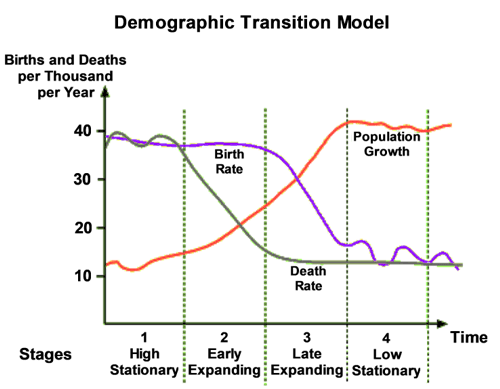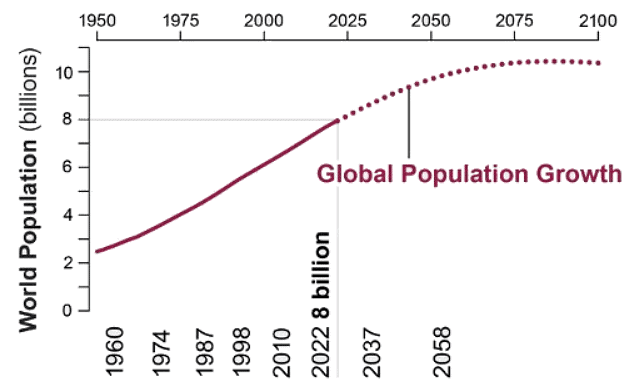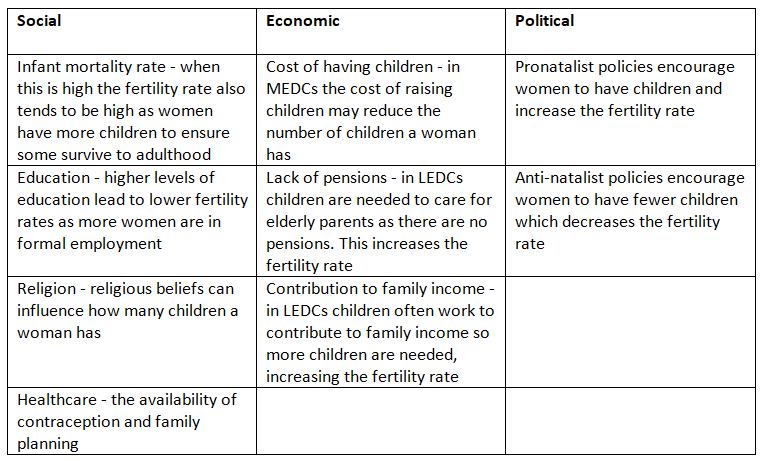Class 10 Exam > Class 10 Notes > Geography for GCSE/IGCSE > Population Change
Population Change | Geography for GCSE/IGCSE - Class 10 PDF Download
Population Change
There are two ways in which a population can change:
- Migration
- Natural population change
Migration
- Migration can lead to population growth or decline, which is influenced by both emigration and immigration.
- Emigration and immigration are the primary factors driving population changes.
- Net migration, calculated as the variance between the number of individuals arriving in a country (immigrants) and those departing (emigrants), determines the overall impact on population size.
Natural Population Change
Natural Causes of Population Change
- There are various factors contributing to the rapid growth of populations, including advancements in:
- Agriculture during the agricultural revolution, resulting in increased yields and more diverse diets.
- Improvements in medicine and healthcare, leading to lower mortality rates.
- Technological advancements and better transportation, creating wealthier societies with increased life expectancies.
- The birth rate has remained high, particularly in Less Economically Developed Countries (LEDCs) due to:
- Limited access to family planning and contraception.
- Higher survival rates of women during childbirth.
- Cultural norms that encourage larger families to provide care for elderly parents and support the family.
- Religious beliefs that promote larger families, which can take generations to change.
- Natural population change is calculated by subtracting the death rate from the birth rate. The combination of a declining death rate and a high birth rate has resulted in rapid natural growth and population surges.
- Population dynamics are also influenced by migration, both into and out of a region.
- Natural decrease occurs when the birth rate falls below the death rate.
Demographic Transition Model
- The demographic transition model outlines the five main stages that countries typically go through as they develop.
- It explains how birth and death rates evolve over time, impacting the country's overall population.

Stage 1
- In Stage 1, the total population remains low.
- High birth rates are a result of limited contraception and family planning methods.
- Elevated death rates stem from inadequate healthcare, poor nutrition, and periodic famines.
- High infant mortality prompts families to have more children to ensure some survive into adulthood.
Stage 2
- During Stage 2, the population begins to grow rapidly.
- Birth rates stay high as families continue having many children.
- Death rates decline due to improved diets, better healthcare services, reduced infant mortality, and enhanced access to clean water sources.
Stage 3
- The total population continues to increase but the rate of growth begins to slow.
- Birth rate starts decreasing rapidly due to factors like increased birth control, family planning, higher cost of raising children, and low infant mortality rate.
- Death rate keeps decreasing, albeit at a slower pace, thanks to advancements in medicine, hygiene, diet, and water quality.
Stage 4
- The total population remains high and is increasing gradually.
- Birth rate is low and fluctuating due to the availability of birth control, the choice of having fewer children, and delaying the age at which women start having children.
- Death rate is low and shows fluctuations.
Stage 5
- Population growth continues at a steady pace.
- Birth rate remains low and varies due to factors like accessible birth control and the decision to have fewer children or delay childbirth.
- Death rate stays low and exhibits fluctuations.
Question for Population ChangeTry yourself: What is the primary factor driving population changes through migration?View Solution
Population Change
- All countries exhibit varying rates of population change.
- LEDCs like Niger, Mali, and Zambia currently experience the highest population growth rates.
- MEDCs generally have lower population growth rates; for instance, countries like Italy and Japan are witnessing a decline in population due to more deaths than births.

- Population changes are influenced by three main factors: Fertility, Mortality, and Migration.
Fertility
- In addition to birth rate, fertility can be gauged through the fertility rate.
- Fertility is influenced by various factors, which can be classified into social, economic, or political categories.

Mortality Factors
Factors affecting death rates include:
- Quality of healthcare
- Access to healthcare
- Natural disasters like famine and drought
- Diseases such as HIV/AIDS
- War and conflict
Case Study: Niger
- In 1960, the population of Niger stood at 3.3 million
- By 2021, the population had surged to almost 25 million
- Niger experienced a population growth rate of 3.8%
- This growth is attributed to a high birth rate and a notable decline in the mortality rate
Factors Contributing to High Birth Rates
Niger's elevated birth and fertility rates can be explained by various factors:
- The average age of marriage is 15.7 years, allowing for more childbearing years for women
- Low levels of education for women, with only 4 out of 10 girls completing primary school
- Emphasis on large families as a societal norm
- Low usage of modern contraception methods, with only 12% of women using them

- The death rate in Niger has shown a decline, dropping from 29 per 1000 in 1960 to 8 per 1000 in 2020.
- This decline can be attributed to several factors:
- Increased urbanization, facilitating access to healthcare and food services.
- Improved food and clean water supply.
- Enhanced access to healthcare facilities.
- Government initiatives to enhance farming practices, leading to increased food availability.
- Provision of free healthcare to pregnant women, improving survival rates for both mothers and infants.
Impacts of Urbanization
- Presence of a highly dependent population, primarily individuals under 15 years old.
- Escalating pressure on educational institutions and healthcare services.
- A younger demographic can potentially boost economic growth, although disparities exist in job opportunities and wealth distribution.
- Rise in rural-urban migration for employment opportunities, leading to the emergence of unauthorized settlements on urban peripheries.
- Challenges like food shortages affecting approximately 2.5 million individuals due to food insecurity.
Reducing Population Growth
Niger took steps in 2014 to decrease fertility rates by implementing the following measures:
- Abolishing child marriage, which refers to marriage under the age of 18
- Enhancing access to education
- Improving availability of health services, contraception, and family planning guidance
- Granting girls and women autonomy to access contraception without parental or spousal consent
- Allowing married or pregnant girls to attend school to support their education
Case Study: Japan
- In 2010, Japan recorded a population of 128.1 million people, which decreased to 125.8 million by 2020. This shift indicates a population change rate of -0.3%, a result of factors such as a low birth rate and an aging population.

Low Birth Rate
- Japan's fertility rate stands at 1.36 births per woman, notably below the replacement rate of 2.1. The country's birth rate is 7.1 per 1000 individuals.
- Several factors contribute to Japan's low birth rate, including:
- Increasing numbers of women prioritizing careers and delaying childbirth.
- Challenges in affording personal residences, leading to 70% of unmarried individuals residing with their parents.
- A decline in marriage rates and a rise in the average age of marriage (29.5 years for women, 31 years for men).
- Economic uncertainties, as job security is not guaranteed.
- The high cost of childcare, making raising children financially burdensome.
Ageing Population
- The death rate in Japan has risen from 6 per 1000 in 1982 to 11 per 1000 in 2020.
- Life expectancy has increased significantly, reaching an average of 84.36 years.
- The aging population, not deteriorating healthcare or living conditions, is the primary driver of the increased death rate.
- Over a third of the population is over 60 years old, and more than 12% are over 75.
- Elderly individuals are more susceptible to illness and mortality, resulting in a higher death proportion with an older population.
Impacts
- As the population ages, there is a significant impact on various aspects of society.
- An increase in the number of elderly individuals results in a shortage of workers.
- This shortage leads to several consequences, such as a decline in innovations and the closure of essential services.
- Furthermore, the burden on the healthcare system and pension funds intensifies due to the aging population.
- Predictions indicate a shortage of 380,000 workers in elderly care by 2025.
- Consequently, taxes may need to be raised to support healthcare and pension obligations.
- Schools and childcare facilities face closure as the number of children decreases, resulting in job losses.
- Each year, approximately 450 schools shut down due to declining student numbers.
- Economic growth stagnates due to the lack of workers and business closures, impacting the overall standard of living.
Solutions
- Development of robots to assist in elderly care, exemplified by the utilization at the Shin-tomi nursing home situated in Tokyo.
- Revision of immigration laws in 2018 to entice foreign workers and alleviate the labor shortage, with a target of attracting 340,000 new workers.
- Initiatives to Boost Birth Rate:
- The Angel Plan of 1994, a five-year strategy, aimed at fostering an increase in the birth rate.
- The subsequent New Angel Plan in 1999 and the Plus One Policy in 2009 were devised to stimulate childbearing by:
- Enhancing work environments to accommodate family responsibilities.
- Improving childcare services.
- Enhancing maternal and child health services.
- Providing better housing for families.
- Upgrading educational facilities.
- Current Approach - Plus One Proposal:
- Introducing the Plus One Proposal, the latest policy endeavor, focusing on enhancing 'parent-friendly' workplaces and constructing 50,000 new daycare facilities.
Question for Population ChangeTry yourself: Which country has experienced a decline in population due to more deaths than births?View Solution
The document Population Change | Geography for GCSE/IGCSE - Class 10 is a part of the Class 10 Course Geography for GCSE/IGCSE.
All you need of Class 10 at this link: Class 10
|
55 videos|68 docs|78 tests
|
FAQs on Population Change - Geography for GCSE/IGCSE - Class 10
| 1. What is the current population trend in Niger? |  |
Ans. The current population trend in Niger is experiencing rapid growth, with a high birth rate and a young population demographic.
| 2. How does Japan's population change compare to that of Niger? |  |
Ans. Japan's population change is characterized by a declining birth rate and an aging population, in contrast to Niger's rapid population growth.
| 3. What factors contribute to the population changes in Niger? |  |
Ans. Factors contributing to the population changes in Niger include high fertility rates, limited access to contraception, and cultural norms that encourage large families.
| 4. How does the government of Niger address the population growth issue? |  |
Ans. The government of Niger has implemented policies and programs to promote family planning, increase access to healthcare, and educate the population on the benefits of smaller family sizes.
| 5. What challenges does Japan face due to its declining population? |  |
Ans. Japan faces challenges such as a shrinking workforce, increased healthcare and pension costs, and a potential decline in economic growth due to its declining population.
Related Searches
















